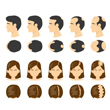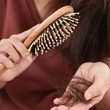Does Diabetes Cause Hair Loss?
With Diabetes, it's not always clear what causes hair loss. Is it medications taken to treat Diabetes? Are there other health conditions that contribute to the problem? Hair loss can be one of the first symptoms of Diabetes. Untreated, it can lead to severe problems. Get all of the information you need to know about the causes of hair loss for people with Diabetes.
Can Diabetes Cause Hair Loss? 2
There is a connection between Diabetes and hair loss; however, many variables to consider, such as your hair's genetics.

Is Diabetes a risk factor for hair loss? The short answer is yes. Diabetes is an autoimmune disease in which the pancreas does not produce insulin. If you have diabetes, your body produces high glucose levels, which will, in turn, lead to poor circulation in the scalp. Poor circulation, in turn, will cause hair to fall out in clumps. Alopecia areata is another autoimmune disorder that affects your immune system and your hair follicles. This can also cause hair loss, but this type of hair loss is usually temporary.
Yes. Diabetes can cause hair loss in some people. However, this is usually temporary and reversible if the blood sugar levels are normalized.
The causes of hair loss are varied, making it difficult to determine whether your hair loss is due to Diabetes. Other causes of hair loss include medications, poor nutrition, stress , heredity, thyroid disorders, anaemia, scalp infections, or injury. Many women lose hair during pregnancy or while they are taking birth control pills. Psychological factors can also cause hair loss.
There are three main types of Diabetes: type 1, type 2, and gestational diabetes. When someone has type 1 or type 2 diabetes, the body cannot produce enough insulin or use the insulin delivered effectively. Insulin is a hormone that helps regulate the amount of sugar in the blood.

This lack of adequate insulin production can cause high blood sugar levels (hyperglycemia). This condition is called hyperglycemia because when too much sugar circulates in the blood, it begins to stick to proteins in the blood, forming compounds called glycosylated haemoglobin (HbA1c).
How to Prevent Hair Loss with Diabetes? 3
Underlying causes may lead to hair loss in diabetics. Understanding the reasons is the first step in stopping this hair loss.
Hair loss in diabetics is common, and it is a cause of concern. There are many reasons for hair loss, and most of these reasons can be treated. Diabetes is one of the underlying causes, and it is essential to know how to control Diabetes to prevent hair loss.
The first step in stopping hair loss caused by Diabetes is to understand the underlying causes. Once you have that information, then you can take steps to prevent further hair loss. You first need to know that two main types of hair loss are commonly seen in people with diabetes. One hair problem is called "androgenetic alopecia," and the other type is called "alopecia areata." Several underlying causes are leading to hair loss in diabetics. These include poor blood circulation, nerve damage, medication side effects, and stress.
Recognizing the Symptoms of Hair Fall Due to Diabetes 4
Hair loss is a symptom of hypoglycemia. The causes of hair loss in diabetes patients differ from those who don't live with the condition.
Signs and Symptoms of Hair Fall in Diabetes Patients:
1. Excessive Graying:One of the early signs of Diabetes is excessive greying of the hair. It can occur in patches or all over the scalp. This may be attributed to poor circulation and a lack of nutrients reaching the follicles.
2. Scalp Itchiness:Scalp itchiness could also be a symptom because when there is excessive growth of fungi on the scalp, it can cause much itching and irritation resulting in bald patches, which may later lead to complete loss of hair. If you feel an unusual itching sensation on your scalp, it's best to see your doctor immediately.
The medical term for hair loss due to Diabetes is alopecia. It is a non-curable condition that affects around 15% of all people with Diabetes. This can be a result of insulin deficiency or insulin resistance.
Insulin is a hormone produced by the pancreas that regulates the amount of glucose in the bloodstream. When a person has too little insulin or becomes resistant to it, their body cannot use glucose as effectively as it should. Consequently, blood glucose levels become too high and too low too often, which can cause problems throughout the body.
Remedies for Hair Loss Caused Due to Diabetes 5
Topical drugs, anti-hair loss supplements, and natural remedies can help treat hair loss.

It is advisable to consult a good doctor specializing in hair loss before using any form of treatment. Doctors will usually test your blood and examine your scalp to determine the causes of hair loss. If it is determined that the grounds are Diabetes-related, they will recommend the necessary treatments.
There are many topical drugs that you can apply directly to your scalp to help treat any hair loss. These include minoxidil, which is applied once or twice a day now to the scalp. Minoxidil is commonly used for hair regrowth, but it also helps with hair loss caused by Diabetes because it increases blood flow to the scalp. This increased blood flow brings more oxygen and nutrients that your hair follicles need to survive and grow healthy hair.
If you're looking for an alternative to minoxidil, other topical drugs like finasteride inhibit DHT production in the body. These drugs are helpful if you suffer from male pattern baldness because they block the conversion of testosterone into DHT, slowing down or even stopping hair loss altogether.
Conclusion 6
There are things you can do to slow down or prevent your hair from falling out as a result of Diabetes. If you have diabetes, it is imperative to keep your blood sugar under control to avoid further complications with your health.
Myth Busters HairFall

Androgenetic Alopecia - Everything You Need To Know
Have you been experiencing excessive hair fall over a prolonged period of time? It could be an early sign of androgenetic alopecia. It is a hair loss disorder common in both genders and can lead to progressive thinning and even baldness in some patients if not caught and treated early.

How To Make Hair Grow Faster For Men
A head full of healthy hair is a matter of confidence. Hair has its own mechanism of growing and shedding, and it is when this mechanism is thrown off that growth is hindered. Especially in the case of males, hair growth faces a lot of hiccups that can easily be managed.

Female Pattern Baldness - Causes & Treatments
Have you suddenly noticed an increase in the number of hair strands on your pillow in the morning? Or is your ponytail getting thinner by day? Well, you might be suffering from female pattern baldness. While that does sound scary, identifying it early on is key to treating this condition effectively. So keep reading to know what this is, how you can identify it, and most importantly, what treatments you can avail of to get your beautiful lustrous hair back.

What Are The Reasons For Hairfall?
Almost everyone experiences some amount of hair thinning over the years. Shedding around 50 to 100 single strands of hair per day is considered normal. However, losing more than 150 strands a day, experiencing sudden thinning, or developing circular bald patches on your scalp are reasons for concern. Hair loss occurs when new hair doesn’t grow fast enough to replace the amount of hair you lose daily. Hair can fall due to various reasons, with hereditary hair loss and poor nutrition being the most common hair fall reasons.

Expert Approved Tips For Hair Growth
What can be more debilitating than seeing hundreds of hair strands shedding from your scalp every time you brush your hair? Also, excessive molting occurs during seasonal changes that can be very stressful for you. Although it’s okay to lose between 50-100 strands every day, according to the American Academy of Dermatology, the problem occurs when you start shedding more than normal. But that doesn’t mean you have to feel helpless as there are ways to grow your hair back. Even if you are coping with baldness or alopecia, certain hair growth tips from dermatologists can come to your rescue. Read on to discover how these tips can be your savior when abnormal hair fall problems are in sight.
Trending Videos
+ 6 Sources
'LMRC - GGI-CO-A2-DMA-300001252-300001252-WM-L21-704'
© 2021 Dr. Reddy’s Laboratories Ltd. All rights reserved.